Something happened first when in Aachen, Germany, in the year 1886, inthe shadow of Aachen Cathedral (aka the Dom!), one of the mostlegendary Gothic pilgrimage churches, Mies van der Rohe, modernarchitecture's wunderkind, was born. Almost a century later, the nextgeneration of Aachen art royalty was birthed through the collaborationof Christoph Heemann and Achim P. Li Khan. In the shadows itself, ofthe Dom's pointed arches and Miesian glass-box skyscrapers, Heeman andKhan's Hirsche Nicht Aufs Sofa was a group on the cusp of contemporaryexperimentation and one possessing, in equal bounty, an almost Gothic,grotesque quality. This rare hybrid, present also in the likes of NurseWith Wound (to which H.N.A.S. is often compared), produced music thateffortlessly resists sounding "dated," and is in many cases some of thebest likely to be heard. The Dom Elchklang and G. Gonge labels are setto reissue a brand new batch of H.N.A.S. (and related) recordings.These first five, however, are considered by many to be the group's"classic" albums.
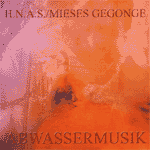 Abwassermusik of 1985 was the first H.N.A.S. LP and was culled from the duo's earlier cassette works. Credited to H.N.A.S. and Mieses Gegonge,the record is the most raw of these first five, relying heavily on themanipulated loops and cut-ups that ground the H.N.A.S. sound, and lesson the unique instrumentation that dominates the next three records. Arudimentary industrial sound carries over most tracks, but hereelements of kraut-rock and tinges of surrealism do emerge. The album'slong centerpiece recalls Throbbing Gristle at first, though evolvesinto a chorus of tribal drums, chirps, and theremin flourishes. As onmost all of these Dom reissues, an album's length of bonus tracks hasbeen added here, most very early, very sparse tape works. Exceptionsand highlights include a pummeling live track from Mieses Gegonge,sounding something like 18 drug-addled Faust-ians grooving in thebottom of a lake, and the first H.N.A.S. vinyl release, an earlyshowcase for Heemann's elegant drones.
Abwassermusik of 1985 was the first H.N.A.S. LP and was culled from the duo's earlier cassette works. Credited to H.N.A.S. and Mieses Gegonge,the record is the most raw of these first five, relying heavily on themanipulated loops and cut-ups that ground the H.N.A.S. sound, and lesson the unique instrumentation that dominates the next three records. Arudimentary industrial sound carries over most tracks, but hereelements of kraut-rock and tinges of surrealism do emerge. The album'slong centerpiece recalls Throbbing Gristle at first, though evolvesinto a chorus of tribal drums, chirps, and theremin flourishes. As onmost all of these Dom reissues, an album's length of bonus tracks hasbeen added here, most very early, very sparse tape works. Exceptionsand highlights include a pummeling live track from Mieses Gegonge,sounding something like 18 drug-addled Faust-ians grooving in thebottom of a lake, and the first H.N.A.S. vinyl release, an earlyshowcase for Heemann's elegant drones.
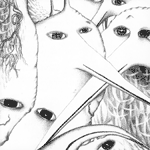 Melchior, released by United Dairies and featuring StevenStapleton and wife Diana Rogerson, is the first in the great trilogy ofearly H.N.A.S. albums. The increased influence of surrealism is notablefrom the start in a brilliant faux-lounge number complete withRogerson's twisted croon. The record is indulgently theatrical in manyplaces; humorous shouting bits and guitar flourishes fill the gapsbetween more overt kraut-rock borrowing (surprisingly Achim has said atthe time the band "knew nothing about Faust, Neu! and all the OHR/Krautbands...") and handclap-ful post punk jogs. The whole mess isbeautifully paced with soothing guitar lines and Heemann's incomparabledrones rescuing each moment of acid-headed confusion. Bonus tracks aremainly '85/'86 era H.N.A.S. tunes, including one of the first (andbest) songs recorded by the Melchior line-up, a gnarled landscape oftrumpet squeal and organ pulse with the spoken refrain, "Listen to thesun rise, hear the birds scream." Experimentation with a variety ofunlikely instruments is at a high among these tracks, creating anatmosphere so difficult to place that it belongs solely to the agelessobscurity of the Dadaists.
Melchior, released by United Dairies and featuring StevenStapleton and wife Diana Rogerson, is the first in the great trilogy ofearly H.N.A.S. albums. The increased influence of surrealism is notablefrom the start in a brilliant faux-lounge number complete withRogerson's twisted croon. The record is indulgently theatrical in manyplaces; humorous shouting bits and guitar flourishes fill the gapsbetween more overt kraut-rock borrowing (surprisingly Achim has said atthe time the band "knew nothing about Faust, Neu! and all the OHR/Krautbands...") and handclap-ful post punk jogs. The whole mess isbeautifully paced with soothing guitar lines and Heemann's incomparabledrones rescuing each moment of acid-headed confusion. Bonus tracks aremainly '85/'86 era H.N.A.S. tunes, including one of the first (andbest) songs recorded by the Melchior line-up, a gnarled landscape oftrumpet squeal and organ pulse with the spoken refrain, "Listen to thesun rise, hear the birds scream." Experimentation with a variety ofunlikely instruments is at a high among these tracks, creating anatmosphere so difficult to place that it belongs solely to the agelessobscurity of the Dadaists.
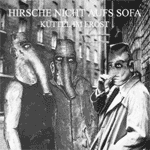 Recorded around the same time as Melchior, Küttel Im Frostis often described as the most pop of H.N.A.S. records. According toAchim, its primary influence was early Chrome, but where it is at allsimilar, Küttel towers above its peers. Rogerson's vocalsreturn, but they've gone from surreal chanteuse to psych screamer. Theastounding title track marks a peak in kraut-rock similarity withoutgiving an inch; it's quickly and artfully unclear how much of a mockeryKüttel's mish-mash of raucous pop and noise-burst is supposed tobe. Bonus tracks all come from H.N.A.S.' first of only two liveappearances. The concert is an excellent addition to this disc as muchof the performance comes from the Küttel album.
Recorded around the same time as Melchior, Küttel Im Frostis often described as the most pop of H.N.A.S. records. According toAchim, its primary influence was early Chrome, but where it is at allsimilar, Küttel towers above its peers. Rogerson's vocalsreturn, but they've gone from surreal chanteuse to psych screamer. Theastounding title track marks a peak in kraut-rock similarity withoutgiving an inch; it's quickly and artfully unclear how much of a mockeryKüttel's mish-mash of raucous pop and noise-burst is supposed tobe. Bonus tracks all come from H.N.A.S.' first of only two liveappearances. The concert is an excellent addition to this disc as muchof the performance comes from the Küttel album.
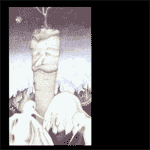 Im Schatten Der Möhre, the third of the truly amazing earlyH.N.A.S. works and the only one Heemann has felt necessary to reissueon his Streamline label, combines the tenuous, staged beauty of Melchior and the twisted jubilation of Küttel to glorious effect. More dense and cohesive than its predecessors, Im Schattenis also less humorous and more demanding. As such, the album could bethe group's most substantial. Bonus tracks here continue on Im Schatten'smore abstract bent, fore-grounding Heemann's future work in Mimir andMirror. Most are compilation tracks or studio outtakes from the '89-'91period, samples, tape loops, and guitar licks (courtesy of Heeman andbrother Andreas Martin) have never been harder to peel apart or label.
Im Schatten Der Möhre, the third of the truly amazing earlyH.N.A.S. works and the only one Heemann has felt necessary to reissueon his Streamline label, combines the tenuous, staged beauty of Melchior and the twisted jubilation of Küttel to glorious effect. More dense and cohesive than its predecessors, Im Schattenis also less humorous and more demanding. As such, the album could bethe group's most substantial. Bonus tracks here continue on Im Schatten'smore abstract bent, fore-grounding Heemann's future work in Mimir andMirror. Most are compilation tracks or studio outtakes from the '89-'91period, samples, tape loops, and guitar licks (courtesy of Heeman andbrother Andreas Martin) have never been harder to peel apart or label.
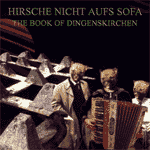 The release that should be the least substantial, 1988's The Book of Deingenskirchen,comprised of the group's unaltered '86 - '88 studio leftovers, is oddlyone of the most entertaining. Understandably more choppy and raw than Aberwassermusik, Bookfeatures a bare-bones industrial sound with elegant, even playfulinterludes and spoken female vocals throughout. Despite its beingessentially a trash heap, Book is the most soothing of allearly H.N.A.S.; comparable to falling in and out of sleep during an oldGerman art film. The bonus material here is by far the most various,collecting obscure compilation tracks from '85 to '92. Bizarre Melchior-ianswing tunes line up next to driving kraut grooves, pseudo-surf tracks,alien drones and absurd found sounds, all effortlessly pieced togetherin the way only H.N.A.S. can, or would.
The release that should be the least substantial, 1988's The Book of Deingenskirchen,comprised of the group's unaltered '86 - '88 studio leftovers, is oddlyone of the most entertaining. Understandably more choppy and raw than Aberwassermusik, Bookfeatures a bare-bones industrial sound with elegant, even playfulinterludes and spoken female vocals throughout. Despite its beingessentially a trash heap, Book is the most soothing of allearly H.N.A.S.; comparable to falling in and out of sleep during an oldGerman art film. The bonus material here is by far the most various,collecting obscure compilation tracks from '85 to '92. Bizarre Melchior-ianswing tunes line up next to driving kraut grooves, pseudo-surf tracks,alien drones and absurd found sounds, all effortlessly pieced togetherin the way only H.N.A.S. can, or would.
samples:
- Brate Mich Auf Offenem Feuer (Melchior)
- Grundgutiger! Der Drang Verstarkt Sich (Küttel Im Frost)
- Im Land Der Möhre (Im Schatten Der Möhre)
Read More

